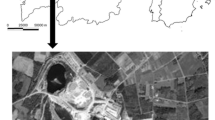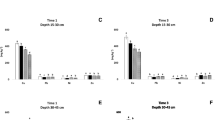Abstract
A large number of studies on the reclamation of mine soils focused on the problem caused by metals and did not explore in depth the issue of nutrients and vegetation after the application of organic materials. The aim of this study was to compare the effect of two treatments made of wastes and vegetated with Brassica juncea L. on the fertility of a settling pond mine soil. The first treatment was compost, biochar, and B. juncea (SCBP) and the second treatment was technosol, biochar, and B. juncea (STBP). This study evaluated the effect of the treatments on the soil nutrient concentrations and fertility conditions in the soil amendment mixtures, after 11 months of greenhouse experiment. Total carbon and nitrogen concentrations were higher in treatment SCBP than in treatment STBP after 7 months but, after 11 months, carbon concentration was higher in STBP. The used technosol could have forms of carbon more stable than compost, which could be released slower than in the compost-amended soils. Both compost and technosol mixed with biochar also increased the concentration of calcium, potassium, magnesium, and sodium in exchangeable form in the mine soil.






Similar content being viewed by others
References
Acosta, J. A., Abbaspour, A., Martínez, G. R., Martínez-Martínez, S., Zornoza, R., Gabarron, M., & Faz, A. (2018). Phytoremediation of mine tailings with Atriplex halimus and organic/inorganic amendments: a five-year field case study. Chemosphere, 204, 71–78.
Beesley, L., Moreno-Jiménez, E., Gomez-Eyles, J. L., Harris, E., Robinson, B., & Sizmur, T. (2011). A review of biochars’ potential role in the remediation, revegetation and restoration of contaminated soils. Environmental Pollution, 159, 3269–3282.
Christensen, B. T. (2004). Tightening the nitrogen cycle. In P. Schjonning, S. Elmholt, & B. T. Christensen (Eds.), Managing soil quality (pp. 44–66). London: Challenges in Modern Agriculture. CABI Publishing.
Conesa, H. M., Faz, Á., & Arnaldos, R. (2006). Heavy metal accumulation and tolerance in plants from mine tailings of the semiarid Cartagena–La Unión mining district (SE Spain). Sci Total Environ, 366, 1–11.
Gandolfi, I., Sicolo, M., Franzetti, A., Fontanarosa, E., Santagostino, A., & Bestetti, G. (2010). Influence of compost amendment on microbial community and ecotoxicity of hydrocarbon-contaminated soils. Bioresource Technology, 101, 568–575.
Hendershot, W. H., Duquette, M. (1986). A simple barium chloride methods for determining cation exchange capacity and exchangeable cations. Soil Sci Soc Am J, 50, 605–608.
Houba, V. J. G., Temminghoff, E. J. M., Gaikhorst, G. A., & Vark, W. (2000). Soil analysis procedures using 0.01 M calcium chloride as extraction reagent. Commu soil Sci Plan, 31(9–10).
Huang, M., Zhu, Y., Li, Z., Huang, B., Luo, N., Liu C, & Zeng, G. (2016). Compost as a soil amendment to remediate heavy metal-contaminated agricultural soil: mechanisms, efficacy, problems, and strategies. Water Air Soil Pollut, 227–359.
IBI. (2016). International biochar initiative [WWW document]. URL http://www.biochar-international.org/
IUSS Working Group WRB. (2014). World reference base for soil resources. International soil classification system for naming soils and creating legends for soil maps. Italy: Rome.
Lehmann, J., Rillig, M. C., Thies, J., Masiello, C. A., Hockaday, W. C., & Crowley, D. (2011). Biochar effects on soil biota. A review. Soil Biology and Biochemistry, 43, 1812–1836.
Lehmann, A., & Schad, P. (2007). Soils. In Section 2: global change and environmental risk assessment world reference base for soil resources.
Manzano, R., Silvetti, M., Garau, G., Deiana, S., & Castaldi, P. (2016). Influence of iron-rich water treatment residues and compost on the mobility of metal(loid)s in mine soils. Geoderma, 283, 1–9.
Parraga-Aguado, I., González-Alcaraz, M. N., Schulin, R., & Conesa, H. M. (2015). The potential use of Piptatherum miliaceum for the phytomanagement of mine tailings in semiarid areas: role of soil fertility and plant competition. Journal of Environmental Management, 158, 74–84.
Porta, J. (1986). Técnicas y experimentos en Edafología. In Collegi Oficial D’Enginyers Agronoms de Catalunya. Barcelona: Spain.
Puga, A. P., Abreu, C. A., Melo, L. C. A., & Beesley, L. (2015). Biochar application to a contaminated soil reduces the availability and plant uptake of zinc, lead and cadmium. Journal of Environmental Management, 159, 86–93.
Puga, A. P., Melo, L. C. A., de Abreu, C. A., Coscione, A. R., & Paz-Ferreiro, J. (2016). Leaching and fractionation of heavy metals in mining soils amended with biochar. Soil and Tillage Research, 164, 25–33.
Rodríguez-Vila, A., Asensio, V., Forján, R., & Covelo, & E.F. (2016). Chemical fractionation of Cu, Ni, Pb and Zn in a mine soil amended with compost and biochar and vegetated with Brassica juncea L. J Geochemical Explor, 158, 74–81.
Saarnio, S., Räty, M., Hyrkäs, M., & Virkajärvi, P. (2018). Biochar addition changed the nutrient content and runoff water quality from the top layer of a grass field during simulated snowmelt. Agriculture, Ecosystems & Environment, 265, 156–165.
Venegas, A., Rigol, A., & Vidal, M. (2016). Changes in heavy metal extractability from contaminated soils remediated with organic waste or biochar. Geoderma, 279, 132–140.
Author information
Authors and Affiliations
Corresponding author
Rights and permissions
About this article
Cite this article
Forján, R., Rodríguez-Vila, A., Cerqueira, B. et al. Comparative effect of compost and technosol enhanced with biochar on the fertility of a degraded soil. Environ Monit Assess 190, 610 (2018). https://doi.org/10.1007/s10661-018-6997-4
Received:
Accepted:
Published:
DOI: https://doi.org/10.1007/s10661-018-6997-4




